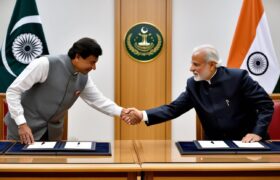Published on: May 10, 2025
Location: New Delhi / Islamabad
Introduction
India and Pakistan, two nuclear-armed neighbors with a history of multiple wars and ongoing tensions over the Kashmir region, have engaged in a significant development toward peace through a reaffirmation of the 2003 ceasefire agreement. This step, while not a permanent resolution, marks a crucial pause in cross-border hostilities and a move towards diplomatic engagement.
Ceasefire Announcement (May 10, 2025)
-
Ceasefire between India and Pakistan came into effect at 5:00 PM IST (11:30 GMT) on May 10, 2025.
-
The agreement covers all military actions on land, sea, and air.
-
Officially confirmed by both nations’ foreign ministries.
Background of India-Pakistan Ceasefire
-
2003 Ceasefire Agreement:
The original ceasefire was signed in November 2003, covering the Line of Control (LoC) and other sectors. It significantly reduced cross-border firing, although sporadic violations continued over the years. -
Violations Over the Years:
Ceasefire violations saw a dramatic rise post-2016, particularly after:-
The Uri attack (2016) and India’s surgical strikes
-
The Pulwama attack (2019) and the Balakot airstrikes
-
The abrogation of Article 370 in Jammu & Kashmir (August 2019)
-
Recent Ceasefire Developments (2021 – Present)
-
February 2021 Joint Statement:
On February 25, 2021, India and Pakistan issued a joint statement agreeing to observe the 2003 ceasefire agreement in letter and spirit. This marked the first high-level military communication in years and was brokered through Director General of Military Operations (DGMO) talks. -
Motivations:
-
India’s focus on the LAC with China
-
Pakistan’s internal economic and political challenges
-
Global pressure to reduce tensions in South Asia
-
A desire to curb civilian and military casualties in border areas
-
-
Ground-Level Impact:
-
Significant reduction in cross-border shelling
-
Increase in civilian safety along the LoC
-
Encouragement of back-channel diplomacy
-
Diplomatic and Strategic Implications
For India:
-
Frees up military focus for Eastern border concerns (China)
-
Supports narrative of being a responsible regional power
-
Promotes peace in Jammu & Kashmir, aiding development
For Pakistan:
-
Eases pressure on its eastern front
-
Enhances international image, especially amid FATF scrutiny
-
Offers space for internal political and economic stabilization
For the Region:
-
Reduces humanitarian crisis along LoC
-
Opens possible future dialogues on trade, visa facilitation, and people-to-people ties
-
May lay groundwork for broader conflict de-escalation if sustained
Challenges to Sustained Peace
-
Lack of trust and history of sudden escalations
-
Terror attacks in Kashmir potentially derailing progress
-
No formal peace treaty, only a reaffirmation of 2003 terms
-
Political shifts in either country can reverse progress quickly
Recent Updates (as of 2025)
⚔️ Background of Escalation
-
April 22, 2025: A terror attack in Pahalgam, Jammu & Kashmir killed 26 Hindu tourists.
-
India blamed Lashkar-e-Taiba, a Pakistan-based terror group.
-
In retaliation, India launched “Operation Sindoor” targeting Pakistani military installations.
-
Pakistan responded with “Operation Bunyan Ul Marsoos”, striking Indian military sites.
📊 Impact and Casualties
-
At least 66 people killed, including civilians and soldiers.
-
Major Indian and Pakistani cities went on high alert.
-
Airbases and border zones were on temporary lockdown.
🕊️ Diplomatic Mediation
-
United States played the lead role in brokering the ceasefire.
-
Saudi Arabia and Turkey supported backchannel diplomacy.
-
US President Donald Trump announced the ceasefire and praised both nations.
🛡️ Immediate Responses
India:
-
Closed 32 airports near the western border.
-
Foreign Secretary Vikram Misri confirmed the ceasefire.
-
Emphasized continued zero tolerance on terrorism.
Pakistan:
-
Reopened airspace after ceasefire announcement.
-
Foreign Minister Ishaq Dar welcomed de-escalation but warned of future consequences if provoked.
📅 Next Steps
-
High-level military talks scheduled for May 12, 2025.
-
Discussions will focus on ceasefire enforcement and long-term confidence-building measures.
Conclusion
While the ceasefire is not a resolution to the decades-long conflict, it is a vital confidence-building measure that has immediate humanitarian and strategic benefits. Both countries stand to gain from maintaining peace, though future stability depends on political will, curbing terrorism, and sincere diplomatic engagement.




